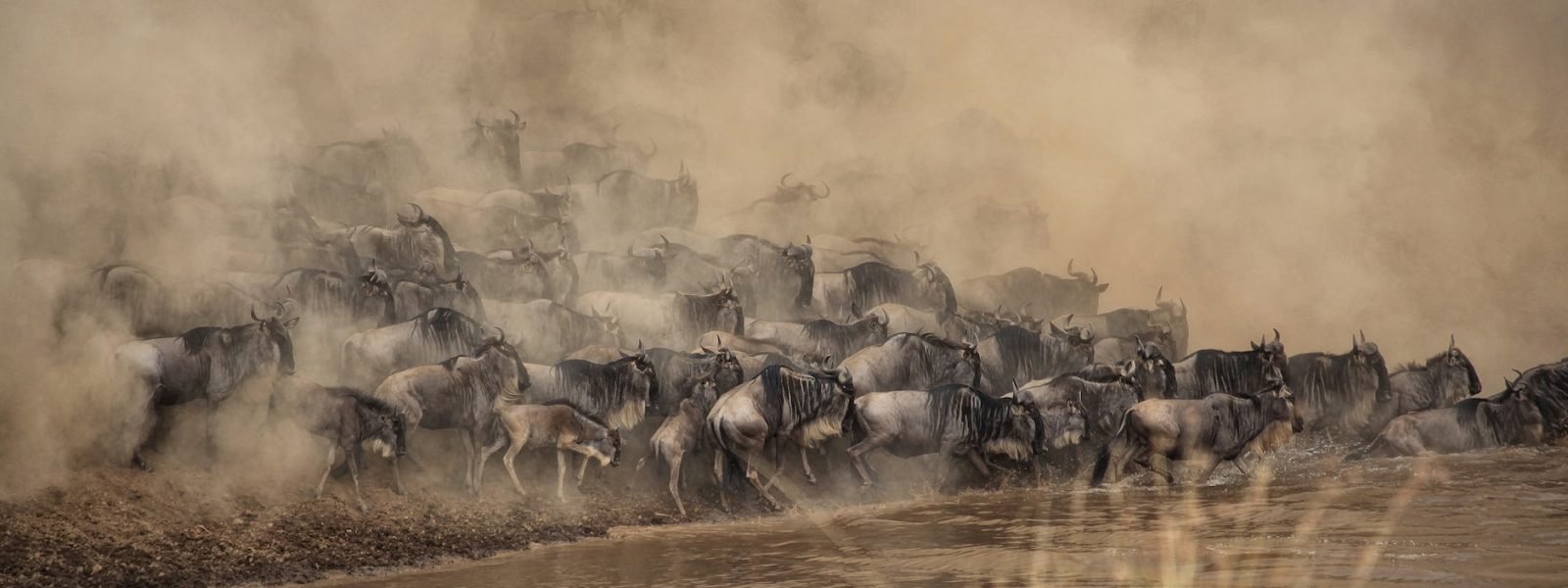The Great Migration is the yearly migration of at least two million ungulates, mostly wildebeest but also a large number of zebra, eland, Grant’s gazelle, and Thomson’s gazelle. The event is the largest of its kind in Africa. The Serengeti migration is dependent on rainfall in the region. There is a reasonably regular annual cycle, although there is also considerable variation from year to year, mostly due to the timing of the wet seasons. The cycle’s primary components are as follows:
January through April
The Serengeti’s primary wildebeest calving grounds are the expanse that stretches southeast from Seronera further into the Ngorongoro Conservation Area, with the Ndutu region of the Serengeti boundary serving as the geographic centre. The wildebeest usually move into this region during the short rains, which start in late November or early December, and remain there until the long rains expire, which usually happens in early May. Due to the lush green surroundings, this is a great time to go on safari in the Serengeti. These southeasterly plains are the most accessible area of the park, especially for those on a budget safari.
The best time to go to this region is during the peak calving season, which is often in February. During this time, thousands of calves are typically delivered daily, and predator concentrations are also at their highest. While you won’t witness the actual migration in March and April, it’s normal to come across herds of 10,000 or more animals migrating in search of better pastures.
May to July
The wildebeest and their retinue often begin to assemble on the southern plains at the end of April in order to get ready for the 800 km northward migration. It’s possible that the migration will begin anytime between the end of April and the beginning of June this year, after being delayed several times in recent years because of tardy fans. One of the most breathtaking sights in the world would be a migration herd of over a million animals in a line over 40 kilometers long.
The passage of the Grumeti River via the Western Corridor, which normally takes place from late June to early July, is the main challenge the wildebeest must overcome throughout this migration.
The first herds to cross are often in the greatest danger, and many animals perish in the crossing, many of them snatched by the Grumeti’s rabid and prodigious population of enormous crocodiles.
Due to this, the actual crossing may not start until two weeks after the first wildebeest arrive at the river’s southern bank, by which time tens of thousands of wildebeest have gathered in the Western Corridor.
July through November
In August, the ungulates often cross the Mara River after making a large northward push through the Grumeti before dispersing into the northwest plains.
According to conventional knowledge, the months of August through October are not the best for visiting the Serengeti since the wildebeest have entered the Maasai Mara National Reserve from Kenya. However, in actuality, roughly half of the wildebeest spend these months in the northwest Serengeti, and game-watching may be great if you can afford to stay at one of the upscale tented lodges in the Mara River region.
In reaction to fluctuations in the local rainfall pattern, relatively small herds of wildebeest—normally between 500 and a few thousand animals—often move back and forth between the northern and southern banks of the Mara River, a really beautiful sight.
In October, if not earlier, the animals frequently cross the Mara River for the final time before starting to saunter back south to the short-grass plains of the southeast. In the Lobo region, there is a fantastic opportunity to observe the southerly migration between late October and mid-November. Late November is when the wildebeest often arrive on the shortgrass plains around Ndutu, where the cycle restarts.
What time should you go for The Great Migration?
You can decide if it is worthwhile to schedule your safari dates around the migration. Even with the best of intentions, it is almost impossible to guarantee that a few days in the Serengeti will coincide with the precise day of a river crossing, which is the most magnificent event in the migration calendar.
Large herds of grazers should be easy to find, and you have a good chance of seeing a more spectacular migrational movement or river crossing if you visit the Serengeti at the right time of year (the southeast from December to May, the Western Corridor from May to July, the Mara River area from July to October, and the Lobo area from October to November).
But there are many reasons to stay put all year, since most predators and ungulate species other than zebras and wildebeest are very territorial and don’t go far from predator territory.
The majority of lodges and camps now have much cheaper rates in April and May, which has an impact on the prices that safari operators are willing to give since they suddenly become competitive. Also, the safari circuit is much less crowded when it’s not high season, and in our experience, you can see as many animals in the Serengeti at any time of year as you can in any African game reserve.





